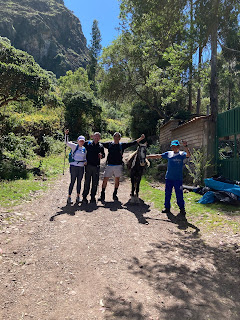As I was initially writing this BK and I were starting our journey back home. This also means that exactly a week ago we arrived in Cusco- where we’re taking off from a bit later today. And what a week it’s been!
 |
| Required travel gear for any public transport in Peru |
Something that I did not fully appreciate before we came on this trip was the fact that everything you do in Peru before your trek is attempting to help you acclimate and prepare for the trek- namely the adjustment to the altitude. Clearly, staying in Lima for a long period of time is not helpful, as it’s at sea level. So off to Cusco we went!
 |
| Cusco hillside |
Cusco is the fourth largest city in Peru, with a population of around 700,000. Kind of weird considering it’s not that much different in population size than to Fort Worth. This might be obvious, but it feels completely different. I feel like it’s North America vs South America more than anything else.
 |
| Cusco square |
When you fly into Cusco you land on a very short runway nestled in the Andes. Prepare yourself for the pilot to hit the brakes hard. Cusco sits at an elevation of about 11,000 feet and coming from Texas, you can feel it immediately. But, like I said, that’s part of the purpose. Also, when you arrive you often receive coca tea, which is said to help with altitude sickness. Everyone said to drink it and chew the leaves...so we did.
 |
| Coca leaves |
Our guide, Alex, met us at the airport and got us to our hotel. BK and I are not ones to sit around, so we pretty much immediately got out to wander around and find some lunch. We hit a great spot that one of his colleagues suggested, Cicciolina. It’s a great little tapas restaurant not too far off the square. That afternoon Alex gave us a brief tour of the central city with more to come on Sunday.
 |
| Cicciolina Restaurant |
Sunday we toured in and around Cusco city. Cusco has been built and rebuilt numerous times. It was the Inka capital and also has a lot of Spanish influence. Many of the buildings around the city have an Inka foundation, meaning they are built on the original stones and foundation where Inka palaces and other buildings once stood. People have not torn these foundations down, rather they added buildings on top of them as the city changed.
 |
| Streets built on Inka ruins |
Between Saturday afternoon and Sunday morning we toured the cathedral, learned about the various squares around the city, toured Qorikancha, went up above the city to see the “white Christ” and also the Tambomachay Archelogical Complex.
 |
| The “White Christ” in Cusco |
The Cathedral is full of what feels like an odd mix of both Catholic and Inka traditions. Even the paintings in the cathedral, which were done by the Cusco School of Painting, are replicas of European paintings but done by locals who made people look local and also incorporated South American touches. An example? There is a painting of the last supper that includes a guinea pig as the food available to share. Interesting and kind of funny.
 |
| Cusco Cathedral |
Most other sites we saw were specific Inka Archological sites. In Qorikancha, which now includes the Convent of Santo Domingo, there are remnants of many Inka temples inside the church complex. You can weave in and out of the temple of the stars, temple of the moon, temple of the sun, and temple of the creator. These remains were uncovered after an earthquake devastated Cusco in the 1950s. The architecture and design of these temples clearly demonstrates they were built to last.
 |
| Perfectly level Inka temples |
 |
| Qorikancha |
We did not get to tour Sacsayhuaman (pronounced saxy woman), as the COVID regulations changed the day before in Peru and required all national parks to be closed on Sunday. More on the constant changes later.  |
| Cusco streets |
That night we went to a nice dinner at Senzo, although with all the large meals we were rarely hungry for dinner. COVID has been devastating to Cusco, who relies on tourism to keep the economy alive. We were the only guests in the restaurant that night and also learned that out of 100 rooms, only 8 were occupied. The whole region continues to hurt for business.  |
| Empty, but great restaurant |
Next up: a tour of the Sacred Valley.














Comments
Post a Comment